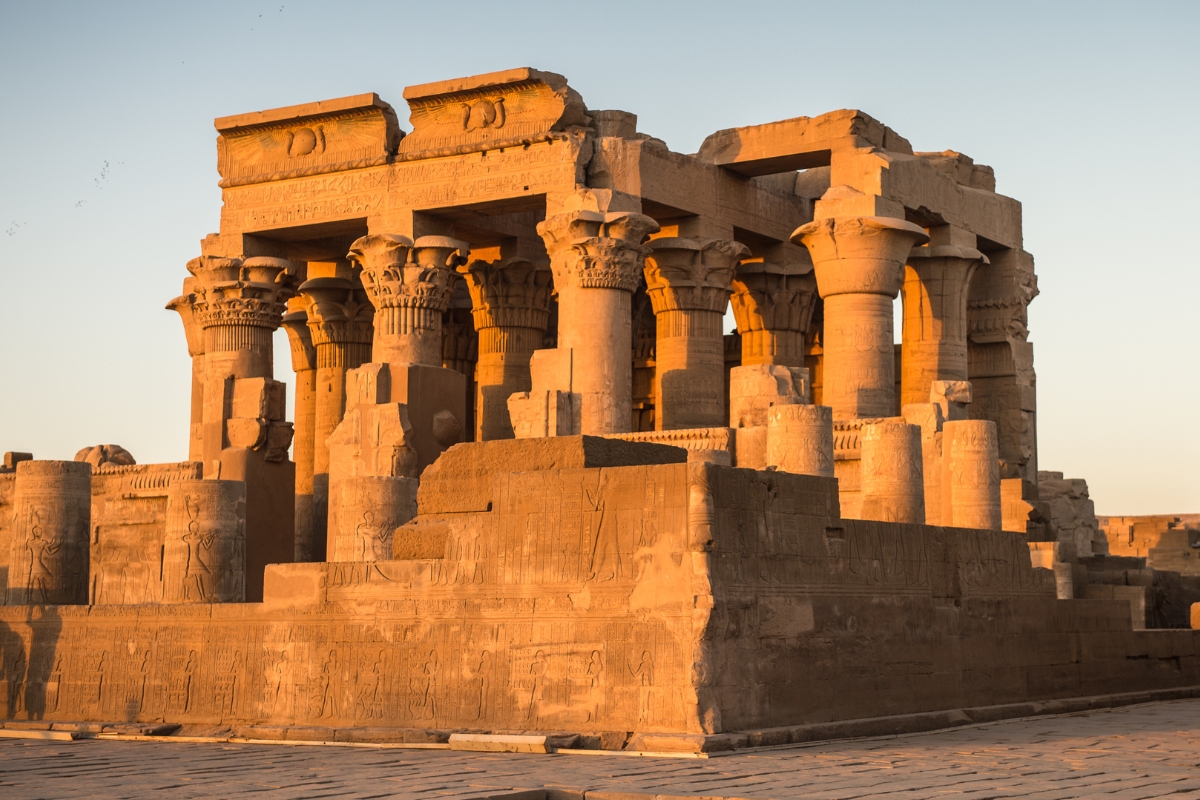


With mind-blowing attractions like the Pyramids of Giza, the Colossi of Memnon, and the tomb of Tutankhamun, it’s no wonder Egypt is the world’s oldest tourist destination. And it remains as alluring as ever.
Thousands of years ago, ancient Greeks and Romans came to marvel at Egypt’s monumental architecture. More recently, French and British ‘experts’ looted its national treasures to fill their own museums, sparking another flood of tourism. Today, 4,500 years after they were built, Giza’s pyramids and sphinx still have the same pulling power.
A lasting legacy
Egypt’s impact is still felt today, in all aspects of life and all over the world. “Egypt provided the building blocks for Greek and Roman culture, and, through them, influenced all of the Western tradition. Today, Egyptian imagery, concepts, and perspectives are found everywhere.”
It’s hard to get your head around just how long-lasting and influential Egyptian culture has been. Ancient Egyptian civilization endured for more than 3,000 years (the USA is barely 250 years old!) and “Cleopatra VII’s reign (which ended in 30 BCE) is closer to our own time than it was to the construction of the pyramids of Giza!”
The pyramids of Giza
Section Type: standardWidthImageS
The Pyramids of Giza, one of the Seven Wonders of the Ancient World, is one of the world’s most sought-after destinations.

While you’d be forgiven for thinking the three massive pyramids at Giza sprung up from nowhere, they were actually the culmination of thousands of years of development and experimentation. The first Egyptian leaders were buried beneath mounds of earth, but these soon developed into huge rectangular monuments called mastabas. About 4,700 years ago, the Egyptians began stacking mastabas on top of one another, in the process creating stepped pyramids. About 100 years later, the first sloping-sided pyramid – the famous Bent Pyramid of Dahshur – was built about 14 miles from Giza.
The three pyramids of Giza were built by three successive generations of kings over a 70-year span. The largest and grandest pyramid – the Great Pyramid of Khufu (aka the Pyramid of Cheops)– is also the oldest. Standing 481 feet tall at the time of completion (it’s shrunk about 30 feet in the 46 centuries since) it remained the world’s tallest building for the next 4,000 years! (It was finally usurped by England’s Lincoln Cathedral in 1311.) The pyramid of Khafre, Khufu’s son and successor, is 10 feet shorter and 1.5 acres smaller, but it’s still a monumental achievement. And the pyramid of Menkaure, Khufu’s grandson, while considerably smaller, is important because its complex burial chambers contained “some of the most stunning examples of sculpture to survive from all of Egyptian history.”
Visiting the pyramids is a truly unforgettable experience. Not only does their juxtaposition against the backdrop of the immense city of Cairo provide one of the world’s great photo ops, but you can also clamber through their internal passageways almost to their summits. (Not recommended for anyone who is unfit, infirm, or claustrophobic.)
The Great Sphinx of Giza
Section Type: standardWidthImageS
It’s believed that the Great Sphinx represents the powerful sun god of Ra-Horakhty and is the incarnation of royal power and the protector of the temple doors.

A few hundred yards from the pyramids, you’ll come across another of Egypt’s most famous attractions. “Known in Arabic as Abu Al Hol (Father of Terror), this sculpture of a man with the haunches of a lion was dubbed the Sphinx by the ancient Greeks because it resembled their mythical winged monster who set riddles and killed anyone unable to answer them.”
As this excellent Smithsonian article explains, “the Sphinx was not assembled piece by piece but was carved from a single mass of limestone exposed when workers dug a horseshoe-shaped quarry in the Giza plateau. Approximately 66 feet tall and 240 feet long, it’s one of the largest and oldest monolithic statues in the world.”
Over the centuries, there’s been a lot of debate about who built the Sphinx, but most scholars now agree “that the Sphinx represents Khafre and forms an integral part of his pyramid complex.” Another enduring myth about the Sphinx is that its nose was broken off by cannonballs fired by Napoleon’s army. This seems highly unlikely, however, as early Arab travelers agree that the nose job was performed hundreds of years earlier. There’s absolutely no doubt about who took the missing part of the Sphinx’s beard: it’s still on display in the British Museum in London.
The Valley of the Kings
Section Type: standardWidthImageS
Mortuary Temple of Queen Hatshepsut, located in the Valley of the Kings.

This monumental site lies on the west bank of the Nile, across from the modern city of Luxor. It’s home to the iconic Colossi of Memnon as well as the tombs of Queen Hatshepsut and, the most famous of the bunch, King Tutankhamun. These three attractions were built more than a thousand years after those at Giza.
The oldest of the three is the mortuary temple of Queen Hatshepsut which was completed in 1458 BC. This elegant three-tiered building at the base of a towering cliff is adorned with magnificent painted reliefs, showing temple rituals, religious festivals, and even Hatshepsut’s expedition to Punt near modern Eritrea. While the temple is primarily dedicated to the queen’s cult, it also contains sections devoted to her father Thutmose I, the goddess Hathor, and the funerary god Anubis.
The Colossi of Memnon, a pair of 60-foot statues of 18th Dynasty Pharaoh Amenhotep III, were completed about 100 years later. Incredibly, they were carved from sandstone quarries near Cairo, 420 miles away, and transported to Luxor by land. They were built to guard Amenhotep’s funerary temple, which is still being excavated. And they became a popular tourist attraction during the Greco-Roman era, almost 2,500 years ago!
The tomb of Tutankhamun was completed about a quarter of a century after the colossi. While King Tut is famous for his magnificent funerary mask of gold and lapis lazuli, he was actually a fairly unimportant king with a rather modest tomb. The reason he’s so famous is that his was the only royal tomb in the Valley of the King to be discovered relatively intact. One can only imagine what riches were contained in the tombs of great leaders like Hatshepsut, Thutmose III, Amenhotep III, and Ramesses II.
The 1922 discovery of King Tut’s tomb by Howard Carter made headlines worldwide. Most of the things Carter found, including the magnificent mask, are housed in the Museum of Egyptian Antiquities in Cairo – one of the world’s great museums. “It is one of history’s great ironies that Tutankhamun, a relatively minor king who was erased from history because he was related to the unpopular King Akhenaten, has come to surpass many of Egypt’s greatest rulers in fame.”
The temples of Karnak, Kom Ombo, and Isis
Section Type: standardWidthImageS
Giant sandstone columns covered in hieroglyphs in Karnak Temple.

Also located near Luxor is the Karnak Temple Complex, a vast assortment of temples, pylons, chapels, and obelisks built, enlarged, amended, and decorated over a period of almost 1,500 years. Karnak was the most important place of worship in Egypt during the New Kingdom (1550 BC – 1350 BC). The highlight is the imposing “Temple of Amun-Ra with its famous hypostyle hall, a spectacular forest of giant papyrus-shaped columns.” It’s best visited early in the morning, before the sun and the crowds make their appearance, and you really need a guide to get the most out of the experience – luckily SA Expeditions’ most popular Egypt itinerary ticks both of these boxes.
If your itinerary includes the Nile – by land or on water – you’ll get the chance to visit a number of other temples between Luxor and Aswan. The Temple of Edfu, also known as Horus, on the west bank of the Nile was built a little over 2,000 years ago. When the pagan cult was banned, the temple complex was filled with desert sand which, unwittingly, preserved the buildings beneath. Incredibly, the roof is still intact.
The Temple of Kom Ombo, meanwhile, is unique as it’s dedicated to two deities: Sobek and Horus. It’s not nearly as well preserved as Edfu, but it does have a fascinating Crocodile Museum which even boasts a few mummified crocs.
Section Type: standardWidthImageS
Temple of Isis within the Philae temple complex.

Last but certainly not least is the magnificent Philae temple complex, located on an island near the town of Aswan. None of the buildings on the island were originally built there: they were all moved to the island before the flooding of Lake Nasser in the 1970s. The centerpiece of this 2,000-year-old assortment is the Temple of Isis which, being about 500 years older than Edfu and Kom Ombo, was the last temple to be built in the classical Egyptian style.
Other highlights on Philae include the “delightful Temple of Hathor, decorated with reliefs of musicians (including an ape playing the lute) and Bes, the god of childbirth” and the “elegant, unfinished pavilion by the water’s edge, known as the Kiosk of Trajan (‘Pharaoh’s Bed’).”
Section Type: cta
Got itchy feet after reading this article? Check out our perennially popular Egypt Highlights & Nile Cruise and our Ancient Egypt by Land tours. Or speak to a Destination Expert about crafting the bespoke Egyptian adventure of your dreams.


Copyright © 2026 SA Luxury Expeditions LLC, All rights reserved | 95 Third Street, 2nd floor, San Francisco, CA, 94103 | 415-549-8049
California Registered Seller of Travel - CST 2115890-50. Registration as a seller of travel does not constitute approval by the state of California.










